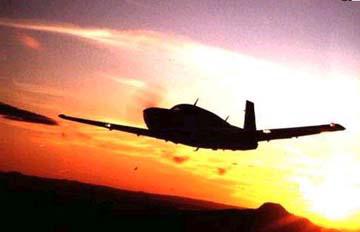
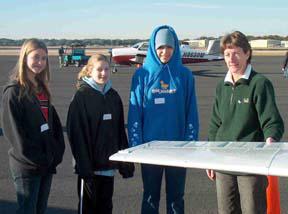
Feb. 28th, Florida to California, 1st leg flight report
A few goodbyes before I set off. First with EAA Chapter 74 of Orlando. Our January Young Eagles day at Orlando Executive, ORL, with 12 planes and pilots, numerous ground support, and 105 kids. Although it was cold, this was a good Saturday for the monthly Young Eagles flight by our Chapter.


Left: EAA Orlando Chapter 74 members Dave Berelsman, Jim Buchan, Tom Carveth, Carol Ann, Bob Caime, Glenn Ball, Ed Rockwell,
Gregg Vogelpohl, Diane Rozek and Real Dupris.
Right: Carol Ann with 3 Young Eagles; it was a chilly 35 degrees F in sunny Florida.
At our February Chapter meeting, I was asked to give a presentation on the planned flight. It was a fun session with experienced pilots giving me good input. Unfortunately, the plane wasn't tanked for the meeting. Below is a picture of the tanks in the plane. There is a 55 gallon drum in place of the two rear seats and a 17 gallon drum replacing the copilot seat all with an FAA approved STC.
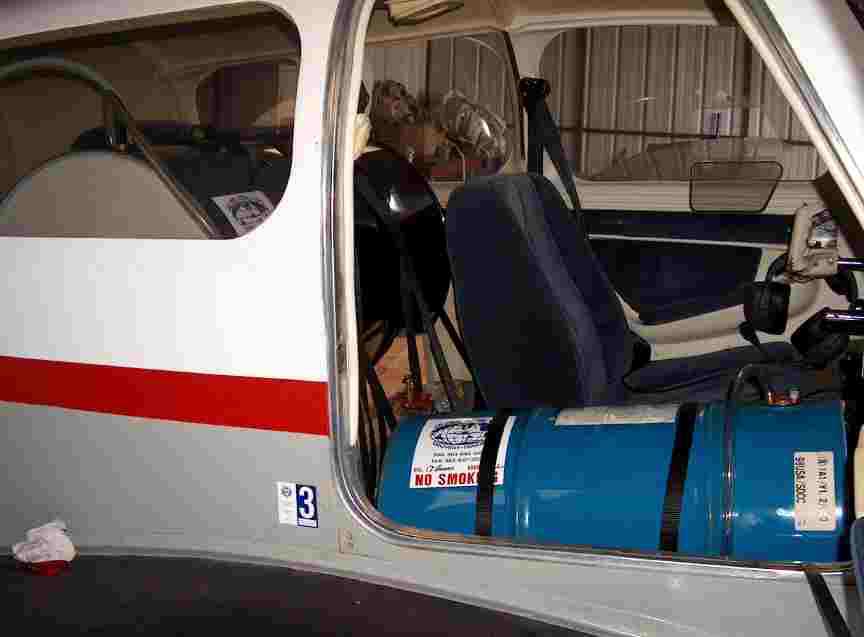
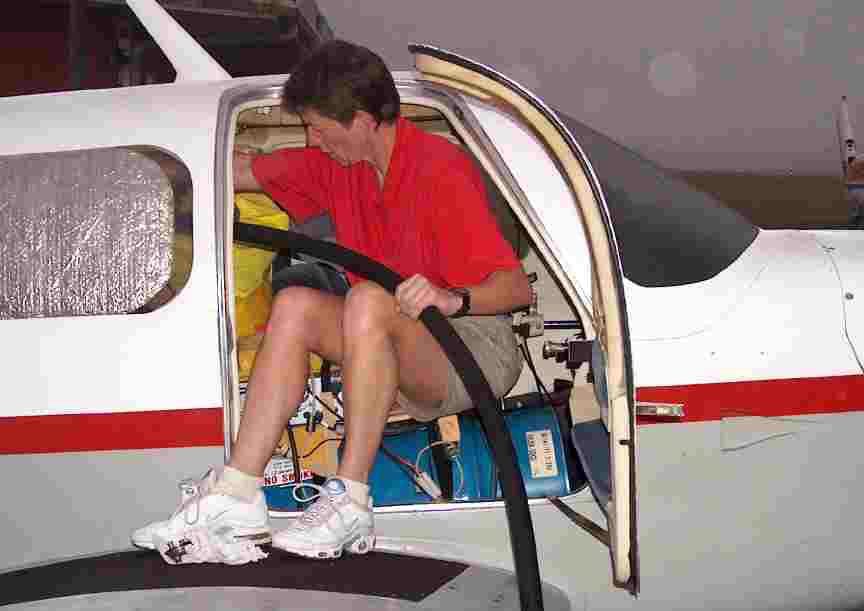
Here we are (me and my Mooney) gassing up and getting ready to go. At 3,107 lbs I was looking forward to a long take-off roll and a very slow climb. Although I didn't need full fuel for this first leg, I wanted to measure the climb rate and runway needed at my maximum load.
I'd tested the HF radio with Wes and Sandy Whitley, Ham operators, on the ground and we'd tried a radio check with New York Radio covering Miami Oceanic on 13291 earlier in February. Everything checked out ok. I am planning to check in with Oakland Radio on the west coast later in this flight as a final test.
Of course in my mind, my take off would be on a sunny day with good visibility. Not so. I'd watched the weather as the final week arrived. Everything else was almost complete and I could leave any day near the end of February. Several fronts had been passing over Texas and through the midwest and east coast. One front was passing over FL near the end of the week with scattered thunderstorms and rain although during that time, the rest of the south looked pretty good and the west coast was getting relief after several days of rain. So, Friday and Saturday looked to be the best for doing the complete leg in one day. Taking two or more days was still an option if the weather continued to be fickle. I chose a Friday morning, 7am departure. With friends, we completed the weighing and loading on Thursday evening and did a final ground test of the HF radio. Everything looked good, so I went home to do the final cleaning (I am renting my house during the 8 months I'll be away) and to get a good night's sleep. Which I did.
Friday morning, up early, check AOPA weather, call Flight Service for a weather briefing and file. The nice St. Pete weather briefer hadn't had to brief a trip to California before -- not too many pilots go non-stop. So, 45 minutes later I was fully briefed. It was pretty much as I'd seen the previous day, but he was able to give more specific information on icing in NM and AZ and where the cells were in the Gulf. The only problem was 200 foot overcast and 1 mile visibility in the Orlando area. I filed for an 8am departure instead of 7am and was mentally ready to leave later. I drove down to the airport as two friends were going to be there at 6am to help me pull the Mooney out of the hangar. We talked for about 45 minutes then pulled the plane out as one guy had to leave for work. I gassed up, 75 gallons on top of the 90 gallons already in the tanks!! I'd increase the air pressure in the tires the evening before and they looked ok under the load. After a pre-flight, we headed to Marathon FBO to look at radar, listen to AWOS, and wait for higher ceilings and better visibility. With an overgross plane and this being my first overweight take off, I didn't want to have a low ceiling to deal with as well. I wanted a few minutes to see how she flew and handled prior to entering clouds. Actually, the ceiling and vis got worse before they got better; but, around 9:30, they started to improve. Dave and I drove back to the south side of the airport.

I received my clearance to POC and taxied to Runway 15; however the wind was switching as we taxied. It became 030 at 8 or 9 knots. I really didn't think it would be good to do a downwind takeoff, so Kissimmee ground let us (me and my Mooney) turn around and taxi to Rwy 33. Runup complete, I was nervous. No question, I'd done all the calculations, and was only supposed to use half the runway and climb at 250 ft/min, but would that be reality? I held the brakes, added power, then released the brakes. Talk about sluggish, it took much longer than I'd anticipated to pick up speed, but then she just kept of going faster, manifold pressure and rpm looked good, she lifted off at 70 k (normally 60 k) with the stall warning buzzer screaming. I concentrated on airspeed and looked quickly to see how much runway I'd used, less than 3000 ft and the numbers had calculated to 2500 ft, not bad. Airspeed was good, climb was anemic, tower advised me that my gear was still down - duhhh. Gear up, flaps up and the climb was still anemic. Tower wished me a good trip and turned me over to Orlando departure and I was in the clouds.
The climb was very slow but uneventful; however it was stressful. 17 minutes later I was level at 6000 ft and breathed a sigh of relief; climb rate 250 ft/min as calculated. Orlando approach asked if I was really going to POC in California without a stop and how long it would take me. When they handed me over, they wished me a good trip and good luck. Actually several of the controllers did that -- very nice of them, thanks.
About an hour later I was on top with only scattered layers above, the flight was smooth and I smiled for the first time and started to feel good. Now this was more of what I had in mind. I still had strong headwinds and although I'd planned 14.5 hours for the trip, the ETE continued to read more than 14 hours. After the FL panhandle the winds diminished, the ETE read 12 hours and I felt much better.
In order to get the cg as far forward as possible, I had the life raft behind my seat. After burning off fuel, I pushed it further back on top of the rear 55 gallon tank, moved my seat back, took off my shoes and really smiled!! I pulled out the Cheerios and started snacking...
It's over 3 hours into the flight with a blanket of clouds that look like snow below me as far as I can see in every direction (maybe this is to prepare me for the sea of blue that I'll be seeing on the next few legs). There are vapor trails from the jets above and their shadows are on the clouds below. I feel like I have company on this flight experience and yet I feel comfortably alone.
OK, how to while away the next 12 hours. After the Cheerios comes the pizza. At a meeting with my EAA Chapter 74, I was asked what I would be eating. I said a sandwich, apples and cookies -- good food, not junk food, I said seriously. Well, cold pizza is my favorite and that's what I ate. That took 15 minutes, now what to do for 11 hrs and 45 minutes. Actually, it wasn't that bad. The time passed very quickly. There was always something to do. I'd flight planned the fuel burn at 9 gal per hour but had used less in the past. Other Mooney pilots recommended 10 or higher planned fuel burn. Well, using the 55 gallon drum of fuel in the back would be the first test. I wanted to run until it was empty.... no use leaving a little and not knowing how much is left. So, at 5 hours (it only has 50 gallons of fuel in it) I started concentrating on the fuel pressure gage and listening to the engine for coughing. Nothing. So 9 g/h would be 5.5 hours, still nothing. 6 hours, nothing. Finally she coughed at 6hr and 30 minutes on that tank, an amazing 7.7 gal/hr at over full load. I'm not leaning too much, the exhaust gases are a nice tan color, just what the doctor ordered. WOW, no problem with plane endurance, only pilot endurance.
I switched to the 17 gallon tank in the right seat, which had 16 gallons in it. 2 hrs and 3 minutes later it coughed again -- yep, I'd had my hand on the fuel selector for at least 15 minutes. 7.8g/h. Now I'm on wing tanks and 100 gallons to go -- let's see, that gives me a conservative 12.5 hours to complete the final 7 hours. I think I have enough reserve.
West of Dallas the clouds ended and I finally saw the ground. Lots of farm fields gave way to dry barren flat land of New Mexico, then the mountains of the Rockies. Sometime in there I took my first potty break. I had not been looking forward to this; but I'd tested the Little John with Lady Jane adapter in my bathroom at home. For the really dirty details, you can see the full story coming to the Women's page in the near future (click on button at top of page). For this rendition, suffice it to say, the Mooney has a small cockpit that isn't designed for women to go potty. I felt relieved afterwards but will drink less water on future trips. Actually, the first test was relatively successful; however, I tried a new position on the second test and that was a little messy.
Back to fun flight details. I had to climb to 10,000 over Roswell NM and up to 12,000 prior to Tuscon AZ. The winds were howling at 40 to 50 knots and slowing my speed to under 90 knots at times. I was bummed and it was dark. As I approached Tuscon, I asked for lower when available. When cleared, I started descending, but immediately was in clouds, ooops, back up I went -- and reported to ATC immediately. I checked the wings and had picked up a trace of ice in no time at all. I stayed at 12,000 and 95 knots until I ran into clouds there, then was cleared to 13,000 ft. I considered landing at Tuscon for the night, but decided to continue and use that as a back up plan. After Tuscon, we received info from a Cherokee ahead and I descended through the clouds to 8,000 ft, clear of clouds but still below freezing. I was back up to 135 knots and smiling again. Finally the cloud layer cleared above and we had a nice starry night again. I continue on. By this time it was 8 pm Pacific time (11pm Eastern) and I'd been flying for 13 hours. I'd eaten my apples and cookies and was saving my chocolates and candy for a sugar high to help clear my head for landing.
I think I received 5 clearance updates between Roswell NM and my arrival. That kept me busy each time, finding the VORs and intersections. I finally climbed to 10,000 ft to cross the last range before descending into the valley. Although I was a little apprehensive about SOCAL approach, it was late enough at night for things to have slowed down a little. He gave me vectors to the ILS 26 L approach (which obviated all the previous clearance updates I'd been given) and I cancelled IFR with the field (tower closed) in sight. 11pm touchdown and not a soul in sight. No-one answered the 24 hr unicom frequency, so I pulled up, tied down and walked around looking for a phone. Not a soul; nor a phone box. I continued walking and finally the night call person showed up. Why didn't you call unicom he asked? Then he checked his radio and sheepishly turned it back on (it had accidentally turned itself off). My brother showed up in 10 minutes, and 10 minutes later we were home sipping a glass of wine and exchanging stories.
In California:
I knew that I'd need a oil change in California, then again in New Zealand. So, we found a nice friendly FBO and with their approval and oil, changed the oil and filter.
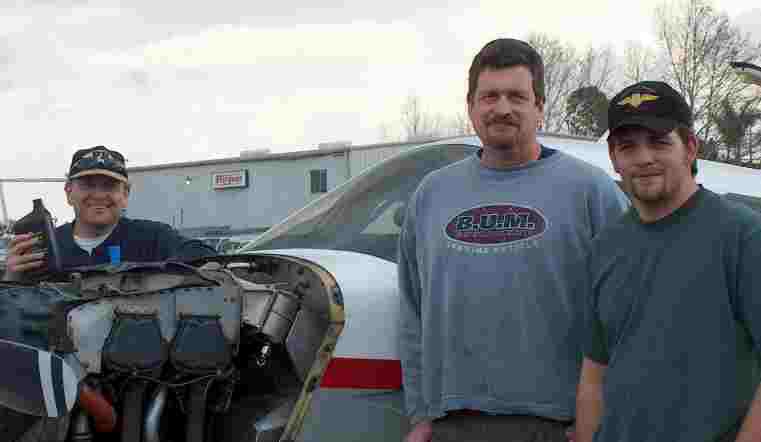

Left is brother Richard Garratt refilling oil while Air Desert Pacific Director of Maintenance, Michael Ward, and son Jeremy talk with us about their favorite airplane, the Mooney. Right is Carol Ann in sunny (cloudy and cool) California. While traveling, it's often the people you meet who make the trip worthwhile. In my case, I'm off to a great start with Mike and Jeremy taking care of me at Brackett Field.
Home / Dedication and Mission / Preparation / across the US to California / First ocean crossing to Hawaii /
Ocean crossing to Samoa / Ocean crossing and flying in New Zealand / Crossing and flying in Australia /
Multiple jumps: Singapore to South Africa / Multiple Jumps: South Africa to Greece / Europe /
Crossing the North Atlantic / Last leg home / About the pilot / About the plane / Supporters /
Overview / Women / Kids / FAQ / Lessons Learned / Family and Friends /
Flight reports: FL to CA / CA to HI / in Hawaii / HI to Am Samoa / Am Samoa to NZ / in NZ / NZ to AU / in AU / in AU2
AU to Singapore / Singapore to India / India to Seychelles / Seychelles to S.Africa / in South Africa / Zambia to Ethiopia /
Djibouti to Greece / Greece to France / England, Ireland, Scotland / to Iceland / to Greenland / to Canada / last legs home
New: Presentations / Book
I'm happy to hear from you, please email me at cagarratt@gmail.com any ideas, suggestions or flight tips. Thanks.
